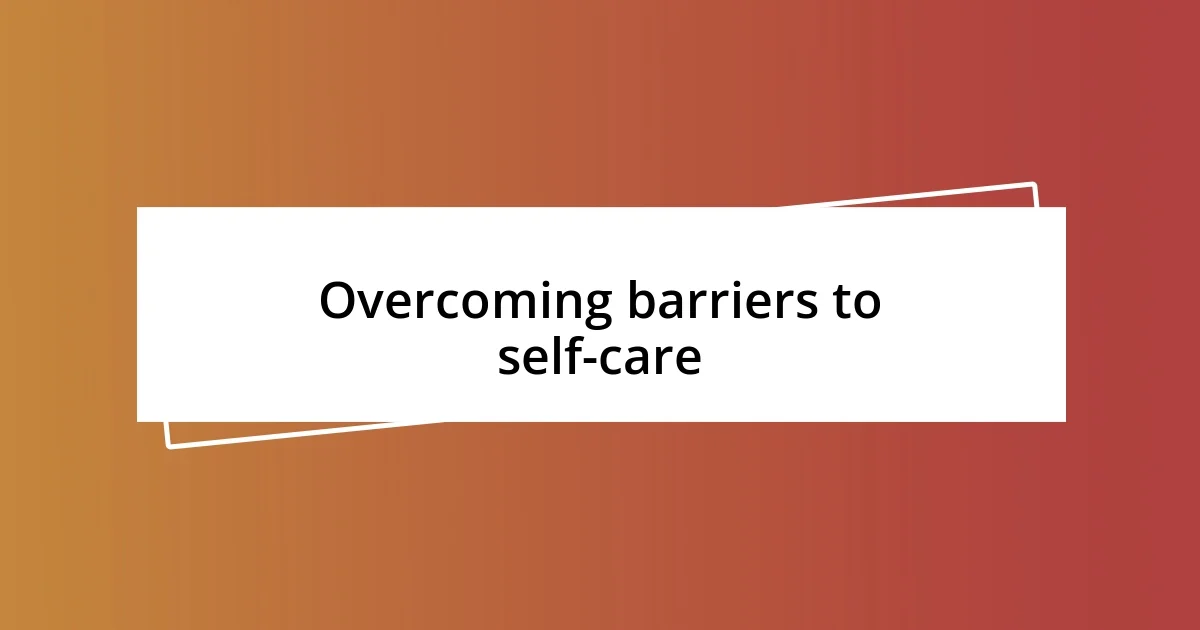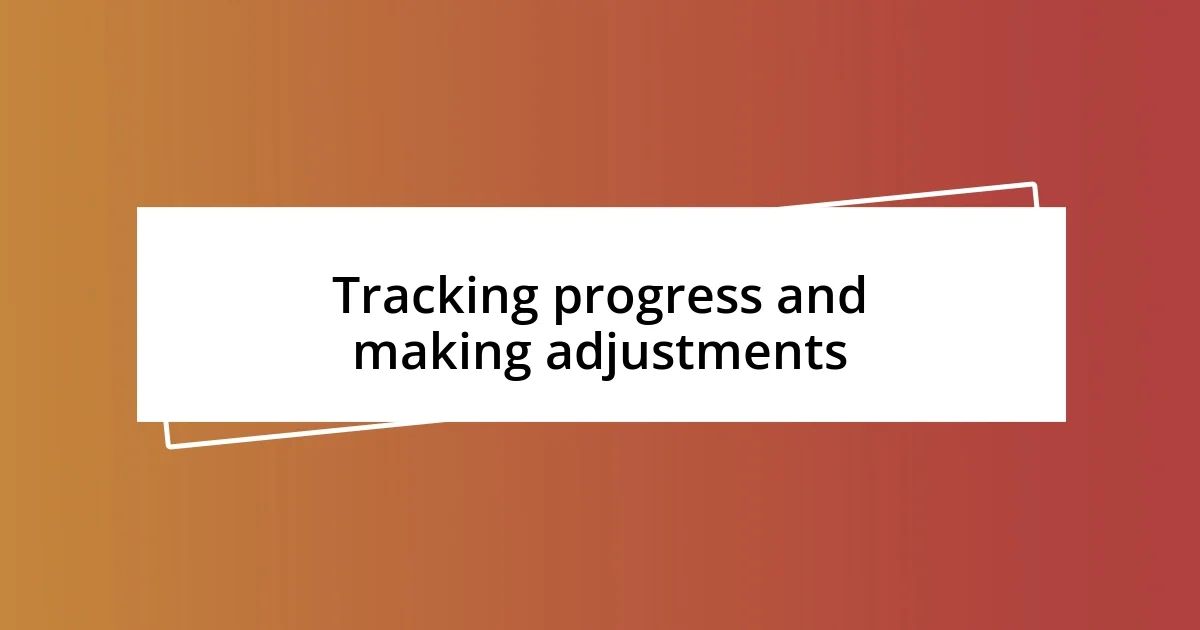Key takeaways:
- Self-care is essential for well-being and should be prioritized to prevent burnout and enhance resilience.
- Identifying personal self-care needs involves reflection and adaptability, recognizing that these needs can change over time.
- Establishing a sustainable self-care routine includes scheduling “me-time,” diversifying activities, and maintaining accountability for long-term commitment.

Understanding the importance of self-care
Self-care is often dismissed as a luxury rather than a necessity, yet I’ve found it to be a cornerstone of my well-being. I remember a particularly overwhelming week when work and personal commitments piled up. In those moments, taking just ten minutes to practice deep breathing or jot down my thoughts in a journal made a world of difference. It’s astonishing how a small act can bring clarity and calm amidst chaos.
Have you ever felt completely drained, struggling to find the energy to face another day? I have, and it’s during those times that I’ve learned to prioritize self-care. A simple walk outside can rejuvenate my spirit, reminding me that I’m part of something larger. This connection to nature helps me reset, reflecting on my feelings and needs. It raises an essential question: how can we attend to our responsibilities if we aren’t attending to ourselves first?
Understanding the importance of self-care is not merely about indulgence; it’s about sustainability. I recall a time when I pushed through exhaustion instead of listening to my body’s signals. That decision led to burnout, teaching me that recognizing my limits is crucial. Self-care isn’t selfish; it’s foundational. By investing time in our own well-being, we cultivate resilience and enhance our capacity to support others.

Identifying personal self-care needs
Identifying personal self-care needs can often feel like searching for a needle in a haystack. I’ve sat down with a cup of tea, reflecting on what truly brings me joy and rejuvenation. One time, I realized that my need was not just physical rest but also creative expression. Whether it was doodling or writing poetry, embracing those creative outlets filled my emotional tank and helped me reconnect with myself.
I often find that self-care needs can change with the seasons of our lives. For instance, during a stressful period, I craved solitude and quietude to recharge. Conversely, in more uplifting times, social interactions and community activities fueled my spirit. It’s a dynamic process, one where I’ve had to learn to tune into my feelings regularly, asking myself, “What do I need right now?” It’s surprising how frequently the answer varies!
Reflecting on my journey, I discovered that identifying my self-care needs often involved trial and error. Initially, I thought self-care was all about spa days and pampering. However, a simple chat with a friend one afternoon revealed that sometimes, just sharing a laugh or seeking support can be the best form of self-care. This realization transformed my perspective and helped me create a balanced routine tailored to my ever-evolving needs.
| Self-Care Area | Personal Needs |
|---|---|
| Emotional | Journaling, talking to friends |
| Physical | Regular exercise, sleep |
| Social | Quality time, community involvement |
| Creative | Artistic hobbies, writing |

Establishing a self-care routine
Establishing a self-care routine has been a transformative journey for me. Initially, I struggled to fit self-care into my busy schedule. But I realized that simply blocking out time for self-care is not enough; it’s about making those moments meaningful. For example, I’ve started every Sunday by dedicating an hour to my favorite hobby—gardening. There’s something profoundly calming about getting my hands in the soil, nurturing plants, and letting my mind wander. This simple act has become a ritual I cherish, allowing me to reset for the week ahead.
To help establish your self-care routine, consider these practical steps:
- Identify non-negotiable times when you can focus solely on yourself.
- Explore activities that energize or calm you and commit to doing them regularly.
- Create a checklist of self-care activities you can do when you have varying time limits—from five minutes to an hour.
- Reflect on your routine every few weeks to see what works and what needs adjustment.
- Stay flexible; life can be hectic, so allow your routine to adapt to your changing needs.
Each step helps in crafting a routine that’s both enjoyable and sustainable, making self-care a cherished part of my life rather than another item on my to-do list.

Integrating mindfulness into daily life
Incorporating mindfulness into my daily life has been a rewarding practice that has genuinely changed my perspective. I began by setting aside just five minutes each morning to sit quietly, focusing on my breath. This simple act, which I initially thought was trivial, blossomed into a powerful anchor throughout my day. Have you ever noticed how just a few minutes of stillness can shift your entire mindset? It’s incredible how that small investment of time can ground me before I even tackle my to-do list.
Throughout my day, I try to infuse mindfulness into everyday activities. When I wash the dishes, I focus on the sensation of the warm water and the rhythm of my movements. This approach helps me be present in those moments, turning mundane tasks into delightful rituals. I’ve found that it’s often during these simple tasks that I experience bursts of creativity and clarity. Isn’t it fascinating how awareness can transform the ordinary into something extraordinary?
As I reflect on my journey with mindfulness, I realize that it’s not just a practice; it is a commitment to living with intention. I frequently pause to check in with myself, asking, “How do I feel right now?” This question encourages me to notice emotions that might otherwise go unacknowledged—whether it’s frustration, joy, or surprise. By embracing these feelings, I’ve learned to process them more wisely rather than letting them control my reactions. It has been a game-changer for my emotional well-being, fostering a deeper connection with myself and my surroundings.

Overcoming barriers to self-care
Many barriers stand in the way of embracing self-care, and I’ve encountered several myself. I remember a time when I felt guilt over taking time for myself—like I was being selfish. It’s a common sentiment, right? But I learned that prioritizing my well-being directly impacts my ability to care for others. Now, I view self-care as a worthwhile investment rather than a luxury.
Time is often cited as a major barrier, and I absolutely understand that struggle. There were days when I’d glance at my calendar and feel overwhelmed. I had to consciously shift my perspective. Instead of thinking, “I don’t have time for this,” I began asking, “What if I prioritized a few minutes for myself?” That change opened doors for those little pockets of joy—whether a quick walk or even a few moments of deep breathing before lunch.
Lastly, financial constraints can feel daunting when considering certain self-care activities. I’ve had weeks where affording a spa day seemed impossible. But then, I discovered that self-care doesn’t have to come with a hefty price tag. Simple homemade masks or a cozy evening with a book can rejuvenate me just as effectively. Why not let that realization guide your self-care journey? Embracing creativity and resourcefulness has truly allowed me to overcome those financial hurdles.

Tracking progress and making adjustments
Tracking my progress in self-care has become an essential part of my routine. I started jotting down notes in a journal, reflecting on what worked and what didn’t. For instance, after a particularly busy week, I realized that I wasn’t making time for my evening walks. Seeing it in writing helped me understand the need to adjust my schedule for better balance. Have you ever felt the clarity that comes from putting pen to paper?
As I analyzed my reflections, I noticed patterns emerging. There were weeks where prioritizing a mindfulness meditation session left me feeling rejuvenated, while others seemed to drain rather than uplift. This awareness prompted me to experiment with different activities, such as trying yoga on days when my mind felt cluttered. It’s fascinating how small tweaks can lead to significant changes in my overall well-being. How often do we overlook the importance of adapting our self-care practices to what we truly need?
Making these adjustments became a game of trial and error, which I found surprisingly liberating. I’ve learned to take comfort in the fact that self-care isn’t a one-size-fits-all solution. Sometimes, I even use an app to track my mood and energy levels throughout the day, allowing me to identify what lifts my spirits the most. Reflecting on these insights has made my self-care approach much more dynamic, and honestly, it’s quite empowering to realize that I can tailor my routine to fit my evolving needs. Don’t you think embracing that flexibility is key to finding balance?

Sustaining long-term self-care practices
Sustaining long-term self-care practices requires commitment and a bit of creativity. I discovered that scheduling “me-time” into my calendar made a world of difference. Initially, it felt strange to block off time for myself, but treating those appointments with the same importance as work meetings slowly shifted my mindset. Have you ever felt guilty about taking time for yourself? I used to, but now I see it as essential, much like refueling a car—without it, I simply won’t run efficiently.
Another aspect I found crucial is having a variety of self-care options. There were times when I felt uninspired or bored with my routine. To combat this, I created a self-care menu—little activities I can choose from based on my mood. For instance, some days call for a cozy read on the couch, while others might prompt me to go for a hike in nature. By keeping my choices fresh and exciting, I’ve noticed it’s much easier to maintain these practices. Doesn’t a menu sound like a fun way to mix things up?
Lastly, accountability has played a significant role in my long-term self-care journey. I reached out to a friend who shared similar goals, and we began checking in on each other’s progress. This support system transformed self-care into something I looked forward to rather than viewed as a chore. I often think about how easy it can be to let self-care slip through the cracks, but having someone invested in my journey makes it feel more valuable. Could having an accountability partner be the nudge you need to stay on track?














